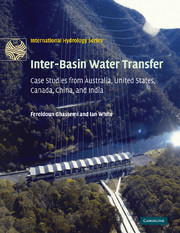Book contents
- Frontmatter
- Contents
- Foreword
- Overview and Scope
- Acknowledgements
- List of Abbreviations
- Part I The Challenges
- Part II Inter-basin Water Transfer in Australia
- Part III Inter-basin Water Transfer in Other Selected Countries
- Part IV Appendices
- Appendix A Some of the Australian pioneers of inter-basin water transfer
- Appendix B Construction timetable of the Snowy Mountains Hydro-electric Scheme
- Appendix C Details of diversion schemes from the Clarence River Basin
- Appendix D Chronological table of the most important events in the Goldfields Pipeline Scheme, Western Australia
- Appendix E Flooding of the Sahara depressions
- Appendix F The Ord River Irrigation Scheme
- Appendix G The West Kimberley Irrigation Scheme
- Appendix H Some other water transfer schemes in Australia
- Appendix I Selected technical features of the Central Valley Project in California
- Appendix J Selected technical features of the State Water Project in California
- Appendix K Selected characteristics of some of the completed or proposed inter-basin water transfer projects in Australia, United States, Canada, China and India, in chronological order
- Glossary
- Index
- References
Appendix H - Some other water transfer schemes in Australia
Published online by Cambridge University Press: 05 November 2009
- Frontmatter
- Contents
- Foreword
- Overview and Scope
- Acknowledgements
- List of Abbreviations
- Part I The Challenges
- Part II Inter-basin Water Transfer in Australia
- Part III Inter-basin Water Transfer in Other Selected Countries
- Part IV Appendices
- Appendix A Some of the Australian pioneers of inter-basin water transfer
- Appendix B Construction timetable of the Snowy Mountains Hydro-electric Scheme
- Appendix C Details of diversion schemes from the Clarence River Basin
- Appendix D Chronological table of the most important events in the Goldfields Pipeline Scheme, Western Australia
- Appendix E Flooding of the Sahara depressions
- Appendix F The Ord River Irrigation Scheme
- Appendix G The West Kimberley Irrigation Scheme
- Appendix H Some other water transfer schemes in Australia
- Appendix I Selected technical features of the Central Valley Project in California
- Appendix J Selected technical features of the State Water Project in California
- Appendix K Selected characteristics of some of the completed or proposed inter-basin water transfer projects in Australia, United States, Canada, China and India, in chronological order
- Glossary
- Index
- References
Summary
INTRODUCTION
Apart from case studies described in Chapters 4–10, numerous other inter-basin water transfer schemes are in operation in various parts of Australia. These include the Shoalhaven Diversion Scheme for Sydney water supply and hydro-power generation, the Thomson Diversion Scheme for Melbourne water supply, and a number of diversion schemes in Tasmania for hydro-power generation. These schemes are described in the following sections. Selected characteristics of some other schemes for water supply of Adelaide, Perth, Darwin and a number of small communities are presented in Table H.1 and their locations are shown in Figure H.1. Information regarding the following proposals is available in Osborne and Dunn (2004, pp. 100–105 and 110–112):
(1) transfer of water from Great Lake in Tasmania to Thomson Reservoir in Victoria;
(2) water transfer from Fly River in Papua New Guinea to Diamantina River in Queensland;
(3) building a national water grid; and
(4) digging a north to south trans-continental canal.
SHOALHAVEN DIVERSION SCHEME
HISTORIC BACKGROUND
Sydney's original water supply (1788–1826) came from the Tank Stream (Figure H.2). The stream, which wound its way through the colony before emptying into Sydney Harbour at Circular Quay, degraded into an open sewer and was abandoned in 1826. Convicts then developed Busby's Bore, a 4 km tunnel leading from the Lachlan Swamps (now Centennial Park) and ending in the south-eastern corner of Hyde Park. By 1852, drought and increasing population led to a call for a more permanent water supply.
- Type
- Chapter
- Information
- Inter-Basin Water TransferCase Studies from Australia, United States, Canada, China and India, pp. 397 - 412Publisher: Cambridge University PressPrint publication year: 2007



